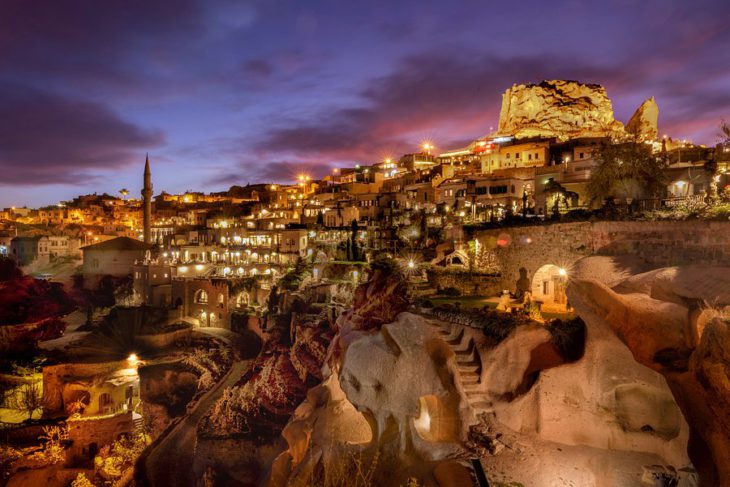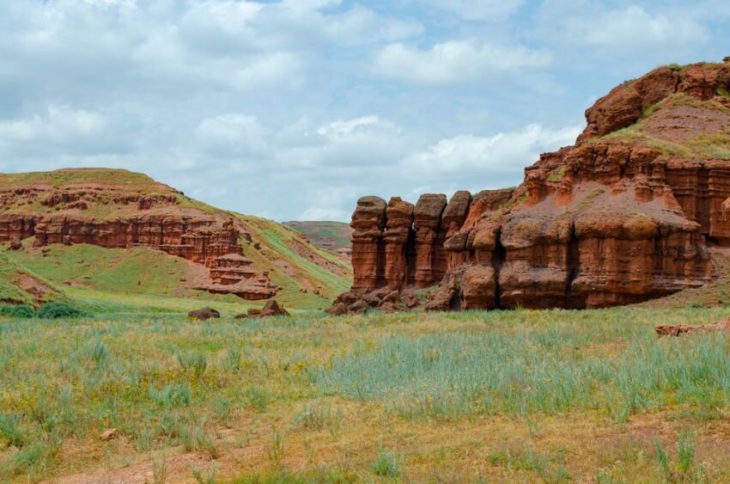
The scene is always fascinating, even to the locals. What else but magic might form rocks and stones into twiggy pillars that grow from the ground, resembling huge mushrooms? How else can geography possibly explain this rather strange phenomenon? Standing tall next to each other, the scenery of these motionless towers appears like the power of old fairies was at work during their formation, or the supernatural had been provoked to anger. Welcome to the fairy chimneys of Turkey, where magic does not exist, yet the traditional and geological stories are always differing. Visitors are immersed in ancient culture and wonder at the geological structures. If you are new to the rough terrain, a tour guide can be useful. You can trek from one of the hotels nearby, hover above the chimneys in a hot air balloon, take a ride on some of the best-trained horses, or join a squad of powerful motorcycles.
What are they?

Millions of years of geological processes fashioned the chimneys into what they are today. It all started miles below the earth where hot lava found its way up and rained hot ashes upon the earth. Eventually, the ash solidified into porous rocks and erosion began its crafty work. Sequences of a thousand years followed and the final structures were enchanting pillars 130 feet above the ground, each with a mushroom-shaped cap. The fairy chimneys aren’t really chimneys, and they have nothing to do with magic or fairy tales. Yet, while geologists can give a fully justifiable answer for their existence, there must be something mystical with these peculiar rock formations in Cappadocia, Turkey. They almost bear the same structure as those found in Utah, New Zealand, France, Canada, Taiwan and Italy. The fairy chimneys are notably distinctive because they were formerly turned into homes. Here’s what you need to know concerning these rare types of geological features.
An adventure for all

The fairy chimneys echo a nature’s welcome to everyone who loves the wonders that millions of years of activities under and over the earth can bring forth. Your travel style is not the issue; the issue is the long-lasting experience you will get. If you are a solo traveler, family, couple or group, the chimney’s magical features will leave every visitor breathless. The tour guides will give you the freedom to opt for a fully escorted private tour, semi-independent tour or a fully self-guided tour if you understand the geography of the area. Depending on your budget, you can visit the chimneys in a single day or spread your itinerary to one or two weeks for a more detailed experience. Stylish hotels dot the areas around the fairy chimneys and you can lodge in one of the traditional hotels or go for a cool night in one of the cave hotels nearby.
The context behind their amazing name

The narrative form the residents say that the word “fairy chimneys” derived from a variety of stories handed down throughout the centuries. The first myth says the hoodoos are actually the chimneys of the secret fairy-houses. The second version describes a tired farmer who realized he might not have the energy to carry his harvest. As he leaned on one of the stones, he observed the fairies carry the harvest to him, and then vanished. The third version refers to a ruler who was outraged after his only daughter fell in love with the shepherd. She eloped and married her boyfriend and gave him a child. Attempting a reunion with her dad, the couple and their child set out for the castle, but the king’s troops had been commanded to execute them. The princess pleaded to God that they would be transformed into a pillar. Her answered prayers are the three Graces fairy chimneys near Urgup.
Variations

The shape of fairy chimneys differs significantly in a fairly tiny region close to the town of Göreme. Also, every valley of fairy chimneys varies in form or even color, and the various shapes are better observed in a hot air balloon. The fairy chimneys in Monks’ Valley look like enormous mushrooms. Several chimneys feature double or even trio caps and one characterizes a chapel devoted to Saint Simeon, a monk who ascended a pillar close to the town of Aleppo in nearby Syria and lived there for many years. A visit to the Sword Valley, also known as Kiliclar Vadasi, will reveal high and pointed fairy chimneys like dagger blades. Those in the pigeon valley are long, thin and fleshy and those in the pigeon valley look like dove cages that have been carved into slouchy fairy chimneys. Pigeons were sometimes kept there for food and soil fertilization through their dung.
Cultural implication

The fairy chimneys at Cappadocia are different from those found in other places because of their great role in shaping people’s culture. Dating back to over 3,500 years, people discovered the hoodoos stone was soft and they began hewing the stones into underground habitats. Some of them were dug under the chimneys and others under the hills. It is thought that the pioneers of the underground homes were the Hittites, Hattians, Phrygians or the Persians. All around the Kaymakli and Derinkuyu towns, there are thirty-six underground cities and each could hold a population of about 10,000 people. Archaeologists suggest that the cities could have been used as safe havens in the time of war. Recent discoveries have also revealed that Christians would hide in the cities when persecution from non-Christians was high. As a result, the cities were not permanent residences. When wars were over, they could emerge and go back to their usual homes.
Best time to visit the fairy chimneys

The ideal season to tour Cappadocia is undoubtedly beyond the hot and sunny summer days of July and August. The period is also the busiest, with visitors congregating inland to this famed region for one day or more away from the coastline. Spring, around April and May, and autumn, from September to October, are special moments of the year, particularly for walking in the valley terrains, with good temperatures and moderate rainfall. It is important to note, furthermore, that early April records stronger winds and which may impact the scheduling of balloon rides. In winter, the continental climatic conditions of Cappadocia suggest that it is highly likely to snow and the scenery is especially serene and breath-taking. If you are visiting during the hot season, the sun can rise to 32′ C and it would be best you go out early before the heat becomes unbearable. A cool evening can particularly be breath-taking as the sunsets across the horizon.
Things to in Cappadocia

Hiking through the valley and sometimes strange rock formations of Cappadocia is a common experience for several tourists, although it is not a good idea to schedule a hiking holiday in the summer. July and August witness Cappadocia sweltering beneath humid, hot weather which is also the peak season of the year, with paths, tourist attractions and views also creeping along with crowds coming from the coastal area for a short visit. If you’d like to go hiking in Cappadocia, plan during spring or autumn. You should not think of Cappadocia as literally an open-air museum – while Göreme’s temples, tunnels and secret towns are truly fascinating sites to explore, Cappadocia is deeply and genuinely vibrant with culture, people here are practicing authentic arts that allow customers to buy beautiful souvenirs or witness the old cultural practices in action. You will attempt your hands at ceramics and cooking lessons or test your taste buds in the vineyards.
Other fairy chimneys to visit

Cappadocia has been often commonly linked with its fairy chimneys, but that’s not the sole location in Turkey where you will see the unique rock formations. Narman is a ten-hour travel east of Cappadocia in eastern Anatolia. The area is nicknamed “Country of the Red Fairies” because of the iron oxide contained in the sandstone mineral of its fairy chimneys. The only difference is that the rocks in Narman are harder and do not easily respond to weathering and water erosion. As a result, you will not find underground caves and cities here. If you want a deeper experience of turkey’s interior, a visit to this place will keep you wanting to visit again. The place is further interior and attracts fewer visitors making it ideal for a quieter visit. Narman’s geological phenomenon is yet to be discovered by many people mainly because it is far interior but it’s a magical place to visit.
Hoodoos of Canada

Located in Hoodoo Mountains, these rock formations stand high above the volcanic mountain. The locals believe the ancient giants solidified into rocks that stand 20 feet above the ground. Although they are not as high and more mystical as the Cappadocia’s fairy chimneys, the hoodoos of Canada are unique and some reach barely a centimeter while others rise to several meters high. The rocks were shaped by years of erosion and forces of strong winds combined with other weathering processes like chemical corrosion. The rock in Canada is harder with a mix of soft strata, which makes the weathering and erosion process faster. The soft layers are mostly sandstone and shale. Like the rocks of Turkey, the hoodoos have caps that slow down the weathering process. The terrain is fragile, which makes it less-trafficked as people avoid the soft volcanic soil. You can trek up the mountain or hire a chopper.
The hoodoos of Utah

The hoodoos of Utah are located in the Bryce Canyon NATIONAL Park and covers about 20 square miles of pink hoodoo rocks. They display a mix of colors from white, yellow, orange and pink. The most important view is the 2-mile wide scenery of clarion rock formations. Visitors can view the spectacular scenery from the road or by following the numerous treks. A drive in the park will take you to the highest point raised about 9 thousand feet above sea level. The grand staircase is one spectacular scene stretching across most of the southern part of Utah. The rock formations are accessible only through one road that runs through the south and the visitor can drive from one viewpoint to the other for a total of 18 miles to the top. While outside the park, you can freely view the first viewpoint called Fairyland point because it’s near the main road.
